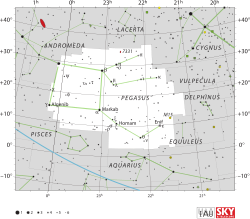9 Pegasi
| 9 Pegasi | |
 | |
| Observationsdata Epok: J2000.0 | |
|---|---|
| Stjärnbild | Pegasus |
| Rektascension | 21t 44m 30,69581s[1] |
| Deklination | +17° 21′ 00,0571″[2] |
| Skenbar magnitud () | +4,35 (V)[3], +4,20 – 4,35 (V)[4] |
| Stjärntyp | |
| Spektraltyp | G5 Ib[5] |
| U–B | +0,96[3] |
| B–V | +1,161 ± 0,005[6] |
| Variabeltyp | Misstänkt variabel[4] |
| Astrometri | |
| Radialhastighet () | -23,11[7] km/s |
| Egenrörelse (µ) | RA: 8,66 ± 0,24[1] mas/år Dek.: -11,33 ± 0,19[1] mas/år |
| Parallax () | 3,52 ± 0,22[1] |
| Avstånd | ca 925 ± 9 lå (276[8] pc) |
| Absolut magnitud () | -2,93[9] |
| Detaljer | |
| Massa | 7,1[5] M☉ |
| Radie | 61[8] R☉ |
| Luminositet | 1 950[10] L☉ |
| Temperatur | 4 910[5] K |
| Metallicitet | -0,04 (Fe/H)[11] dex |
| Vinkelhastighet | 10[5] km/s |
| Ålder | ± 2,1[11] miljoner år |
| Andra beteckningar | |
| HIP 107348[12], HR 8313[12], IRAS 21421+1707[12], SAO 107365[12], 2MASS J21443070+1721001[12], HD 206859[12], GSC 01670-00918[12], AG+17 2413[12], BD+16 4582[12], GC 30444[12], GCRV 13662[12], HIC 107348[12], IRC +20518[12], JP11 3395[12], NSV 13864[12], PLX 5248[12], PLX 5248.00[12], PPM 140574[12], RAFGL 2801S[12], ROT 3162[12], TD1 28411[12], TYC 1670-918-1[12], UBV 18668[12], UBV M 25911[12], uvby98 100206859[12], YZ 17 8858[12], WEB 19384[12], Gaia DR2 1773880252696630784[12] och 9 Peg[13] | |
9 Pegasi, som är stjärnans Flamsteed-beteckning, är en ensam stjärna belägen i den östra delen av stjärnbilden Pegasus, som också har Bayer-beteckningen g Pegasi.[14] Den har en minsta skenbar magnitud på ca 4,35[3] och är svagt synlig för blotta ögat där ljusföroreningar ej förekommer. Baserat på parallaxmätning inom Hipparcosuppdraget på ca 3,5[1] mas, beräknas den befinna sig på ett avstånd på ca 925 ljusår (ca 276 parsek) från solen. Den rör sig närmare solen med en heliocentrisk radialhastighet av ca -23 km/s.[11]
9 Pegasi definieras och används som MK-standardstjärna för spektraltypen G5 Ib.[13][15]
Egenskaper
9 Pegasi är en gul till vit superjättestjärna av spektralklass G5 Ib.[5] Den har en massa som är ca 7[5] solmassor, en radie som är ca 61[8] solradier och utsänder ca 1 950[10] gånger mera energi än solen från dess fotosfär vid en effektiv temperatur på ca 4 900 K.[5]
9 Pegasi är en misstänkt variabel,[4] som har visuell magnitud som varierar mellan +4,20 och 4,35 utan någon fastställd periodicitet.[4][16]
Se även
Referenser
- Den här artikeln är helt eller delvis baserad på material från engelskspråkiga Wikipedia, 9 Pegasi, 24 juni 2020.
Noter
- ^ [a b c d e] Van Leeuwen, F. (2007). "Validation of the new Hipparcos reduction". Astronomy and Astrophysics. 474 (2): 653. arXiv:0708.1752. Bibcode:2007A&A...474..653V. doi:10.1051/0004-6361:20078357.
- ^ ”Basic data: V* 9 Peg – Variable Star” (på engelska). Centre de Données astronomiques de Strasbourg. http://simbad.u-strasbg.fr/simbad/sim-basic?Ident=9+Peg&submit=SIMBAD+search. Läst 5 november 2019.
- ^ [a b c] Ducati, J. R. (2002). "VizieR Online Data Catalog: Catalogue of Stellar Photometry in Johnson's 11-color system". CDS/ADC Collection of Electronic Catalogues. 2237. Bibcode:2002yCat.2237....0D.
- ^ [a b c d] ”NSV 13864” (på engelska). The International Variable Star Index. AAVSO – American Association of Variable Star Observers. https://www.aavso.org/vsx/index.php?view=detail.top&oid=52488. Läst 5 november 2019.
- ^ [a b c d e f g] Lyubimkov, Leonid S.; Lambert, David L.; Kaminsky, Bogdan M.; Pavlenko, Yakov V.; Poklad, Dmitry B.; Rachkovskaya, Tamara M. (2012). "Lithium abundance in atmospheres of F- and G-type supergiants and bright giants". Monthly Notices of the Royal Astronomical Society. 427: 11. arXiv:1212.6057. Bibcode:2012MNRAS.427...11L. doi:10.1111/j.1365-2966.2012.21617.x.
- ^ van Leeuwen (2007). ”Hipparcos, the New Reduction” (på engelska). http://vizier.u-strasbg.fr/viz-bin/VizieR-5?-out.add=.&-source=I/311/hip2&HIP=107348. Läst 5 november 2019.
- ^ Soubiran, C.; Bienaymé, O.; Mishenina, T. V.; Kovtyukh, V. V. (2008). "Vertical distribution of Galactic disk stars. IV. AMR and AVR from clump giants". Astronomy and Astrophysics. 480: 91. arXiv:0712.1370. Bibcode:2008A&A...480...91S. doi:10.1051/0004-6361:20078788.
- ^ [a b c] Van Belle, G. T.; Creech-Eakman, M. J.; Hart, A. (2009). "Supergiant temperatures and linear radii from near-infrared interferometry". Monthly Notices of the Royal Astronomical Society. 394 (4): 1925. arXiv:0811.4239. Bibcode:2009MNRAS.394.1925V. doi:10.1111/j.1365-2966.2008.14146.x.
- ^ ”9 Pegasi” (på engelska). Universe Guide. https://www.universeguide.com/star/9pegasi. Läst 5 november 2019.
- ^ [a b] McDonald, I.; Zijlstra, A. A.; Boyer, M. L. (2012). "Fundamental parameters and infrared excesses of Hipparcos stars". Monthly Notices of the Royal Astronomical Society. 427: 343. arXiv:1208.2037. Bibcode:2012MNRAS.427..343M. doi:10.1111/j.1365-2966.2012.21873.x.
- ^ [a b c] Kovtyukh, V. V.; Gorlova, N. I.; Belik, S. I. (2012). "Accurate luminosities from the oxygen λ7771-4 Å triplet and the fundamental parameters of F-G supergiants". Monthly Notices of the Royal Astronomical Society. 423 (4): 3268. arXiv:1204.4115. Bibcode:2012MNRAS.423.3268K. doi:10.1111/j.1365-2966.2012.21117.x.
- ^ [a b c d e f g h i j k l m n o p q r s t u v w x y z aa ab] SIMBAD Astronomical Database.[källa från Wikidata]
- ^ [a b] Morgan, William Wilson; Keenan, Philip Childs; Kellman, Edith (1943). "An atlas of stellar spectra, with an outline of spectral classification". Chicago. Bibcode:1943assw.book.....M.
- ^ Flamsteed, John; Fortin, Jean Nicolas; De Lalande, Joseph Jerome Lefrancais (1795). "Atlas celeste". Paris : Delamarche. Bibcode:1795atce.book.....F.
- ^ Eggen, Olin J. (1951). "Photoelectric Studies. V. Magnitudes and Colors of Classical Cepheid Variable Stars". Astrophysical Journal. 113: 367. Bibcode:1951ApJ...113..367E. doi:10.1086/145405.
- ^ Samus, N. N.; Durlevich, O. V.; et al. (2009). "VizieR Online Data Catalog: General Catalogue of Variable Stars (Samus+ 2007-2013)". VizieR On-line Data Catalog: B/gcvs. Originally Published in: 2009yCat....102025S. 1. Bibcode:2009yCat....102025S.
Externa länkar
Media som används på denna webbplats
Författare/Upphovsman: IAU and Sky & Telescope magazine (Roger Sinnott & Rick Fienberg), Licens: CC BY 3.0
IAU Pegasus chart


